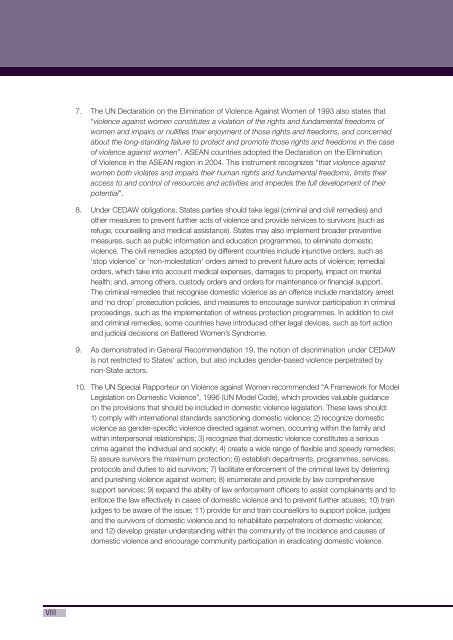Domestic Violence Legislation and its Implementation
Domestic Violence Legislation and its Implementation
Domestic Violence Legislation and its Implementation
You also want an ePaper? Increase the reach of your titles
YUMPU automatically turns print PDFs into web optimized ePapers that Google loves.
EXECUTIVE SUMMARY<br />
VIII<br />
7. The UN Declaration on the Elimination of <strong>Violence</strong> Against Women of 1993 also states that<br />
“violence against women constitutes a violation of the rights <strong>and</strong> fundamental freedoms of<br />
women <strong>and</strong> impairs or nullifi es their enjoyment of those rights <strong>and</strong> freedoms, <strong>and</strong> concerned<br />
about the long-st<strong>and</strong>ing failure to protect <strong>and</strong> promote those rights <strong>and</strong> freedoms in the case<br />
of violence against women”. ASEAN countries adopted the Declaration on the Elimination<br />
of <strong>Violence</strong> in the ASEAN region in 2004. This instrument recognizes “that violence against<br />
women both violates <strong>and</strong> impairs their human rights <strong>and</strong> fundamental freedoms, lim<strong>its</strong> their<br />
access to <strong>and</strong> control of resources <strong>and</strong> activities <strong>and</strong> impedes the full development of their<br />
potential”.<br />
8. Under CEDAW obligations, States parties should take legal (criminal <strong>and</strong> civil remedies) <strong>and</strong><br />
other measures to prevent further acts of violence <strong>and</strong> provide services to survivors (such as<br />
refuge, counselling <strong>and</strong> medical assistance). States may also implement broader preventive<br />
measures, such as public information <strong>and</strong> education programmes, to eliminate domestic<br />
violence. The civil remedies adopted by different countries include injunctive orders, such as<br />
‘stop violence’ or ‘non-molestation’ orders aimed to prevent future acts of violence; remedial<br />
orders, which take into account medical expenses, damages to property, impact on mental<br />
health; <strong>and</strong>, among others, custody orders <strong>and</strong> orders for maintenance or fi nancial support.<br />
The criminal remedies that recognise domestic violence as an offence include m<strong>and</strong>atory arrest<br />
<strong>and</strong> ‘no drop’ prosecution policies, <strong>and</strong> measures to encourage survivor participation in criminal<br />
proceedings, such as the implementation of witness protection programmes. In addition to civil<br />
<strong>and</strong> criminal remedies, some countries have introduced other legal devices, such as tort action<br />
<strong>and</strong> judicial decisions on Battered Women’s Syndrome.<br />
9. As demonstrated in General Recommendation 19, the notion of discrimination under CEDAW<br />
is not restricted to States’ action, but also includes gender-based violence perpetrated by<br />
non-State actors.<br />
10. The UN Special Rapporteur on <strong>Violence</strong> against Women recommended “A Framework for Model<br />
<strong>Legislation</strong> on <strong>Domestic</strong> <strong>Violence</strong>”, 1996 (UN Model Code), which provides valuable guidance<br />
on the provisions that should be included in domestic violence legislation. These laws should:<br />
1) comply with international st<strong>and</strong>ards sanctioning domestic violence; 2) recognize domestic<br />
violence as gender-specifi c violence directed against women, occurring within the family <strong>and</strong><br />
within interpersonal relationships; 3) recognize that domestic violence constitutes a serious<br />
crime against the individual <strong>and</strong> society; 4) create a wide range of fl exible <strong>and</strong> speedy remedies;<br />
5) assure survivors the maximum protection; 6) establish departments, programmes, services,<br />
protocols <strong>and</strong> duties to aid survivors; 7) facilitate enforcement of the criminal laws by deterring<br />
<strong>and</strong> punishing violence against women; 8) enumerate <strong>and</strong> provide by law comprehensive<br />
support services; 9) exp<strong>and</strong> the ability of law enforcement offi cers to assist complainants <strong>and</strong> to<br />
enforce the law effectively in cases of domestic violence <strong>and</strong> to prevent further abuses; 10) train<br />
judges to be aware of the issue; 11) provide for <strong>and</strong> train counsellors to support police, judges<br />
<strong>and</strong> the survivors of domestic violence <strong>and</strong> to rehabilitate perpetrators of domestic violence;<br />
<strong>and</strong> 12) develop greater underst<strong>and</strong>ing within the community of the incidence <strong>and</strong> causes of<br />
domestic violence <strong>and</strong> encourage community participation in eradicating domestic violence.

















